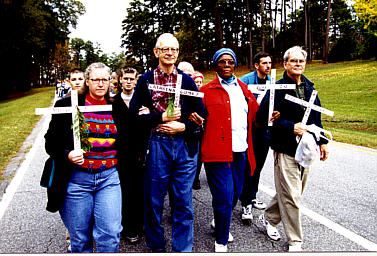General Board of Global
Ministries
![]()
UM Information
![]()
UM Reporter
![]()
Employment
![]()
Archives
![]()
Favorite Places
![]()
![]() Florida Southern College
Florida Southern College
![]()
![]() Bethune Cookman College
Bethune Cookman College
![]()
![]() FL
UM Children's Home
FL
UM Children's Home
![]()
|
|
Florida woman protests training school |
|
Photo by Tom O'Netti |
Carrying a cross bearing the name, Mariquita, a 5-year-old victim of violence in Guatamala, the Rev. Vicki Walker(left), deputy director of Tampa United Methodist Centers, protests with 2,319 people from across the United States the alleged training of Latin American soldiers in murder, torture and extortion. |
| By Michael Wacht LAKELAND — A total of 2,319 people walked onto the grounds of Fort Benning in Columbus, GA, Nov. 22 carrying crosses and coffins, praying, singing and repeating the names of victims of violence and persecution in Latin America in protest of the training taking place at the army base’s School of the Americas (SOA). The Rev. Vicki Walker, a deacon in the Florida Conference serving Tampa United Methodist Centers, was one of them. Walker says the school is really “a training ground for terrorism and torture.” “Most Americans are not aware of the school and what things are being taught in our name,” she said. “I felt like we were training third-world military forces to oppress their own people and to oppress anyone who was organizing workers or teaching literacy…Christian leaders, teachers, nuns, priests, union leaders.” Debate over the school among United Methodists and other groups has grown in recent months, but questions were first raised by Father Roy Bourgeois, a catholic priest, who began protesting United States policy toward Latin America in 1980. His research convinced him that SOA graduates were responsible for much of the violence and bloodshed in Latin America. In 1990, he formed School of the Americas Watch (SOAW), which began lobbying the United States government to close the school in 1994. According to the school’s internet web site, SOA has graduated more than 57,000 officers, cadets, noncommissioned officers and government civilians from 22 Latin American countries and the United States since its inception in 1946. It’s historic mission was to teach Latin American military forces democratic principles, including civilian control of the military, and to prepare them to fight against communist insurrection. Today, the school says it trains Latin American police and soldiers to respond to threats, including “narcotrafficking, terrorism, natural and environmental catastrophes, and the civil strife which they may engender.” It also says human rights training is an integral part of its curriculum, with every student required to complete a core of human rights training. According to “School of Assassins,” a newsletter published by SOAW, the school’s graduates include former Panamanian dictator Manuel Noriega, Salvadoran death squad leader Roberto D’Aubuisson, and former dictators of Argentina, Peru, Ecuador and Bolivia. Former Rep. Joseph Kennedy II (D-Mass.) said in the executive summary of a bill he sponsored to close the school that SOA training manuals “taught murder, torture and extortion.” SOA says objections to the school are based mostly on ideological differences. “Many of the critics supported Marxism — Liberation Theology — in Latin America, which was defeated with the assistance of the U.S. Army. In other words, they lost the war, were expelled from the region, and now are going after one of the mechanisms which assisted in promoting and maintaining democratic ideals,” the school’s web site said. Walker said she first became aware of American military intervention in Latin America in 1989 after traveling to Nicaragua, Guatemala and Honduras. She met people there who told her of the atrocities being committed and visited a church where every man in the surrounding village was executed. “There were still bullet holes in the walls and ceilings,” she said. At first she defended American foreign policy: “I thought all those people must be wrong.” After doing research on the subject and hearing about the April 30, 1998 resolution by the United Methodist Council of Bishops “urging President Clinton and Congress to close the School of the Americas as an act of solidarity with the poor and marginalized of Latin America,” Walker said she changed her mind. “My memories of the people I met changed my life,” she said. “The victims and the voiceless can’t come here and take a stand, so I did it for them.” Although she was afraid of the impact a possible arrest could have on her life, Walker said the protest was something she had to do: “I really felt that if I’m a Christian — which I am — I have to be willing to take a stand on injustice.” Top
of this page |

